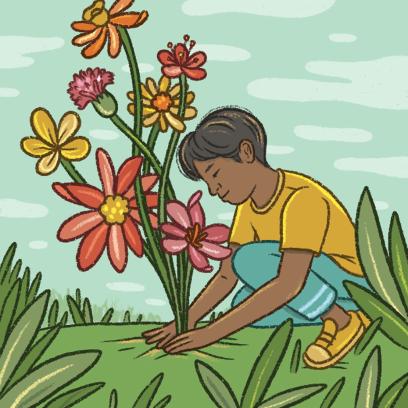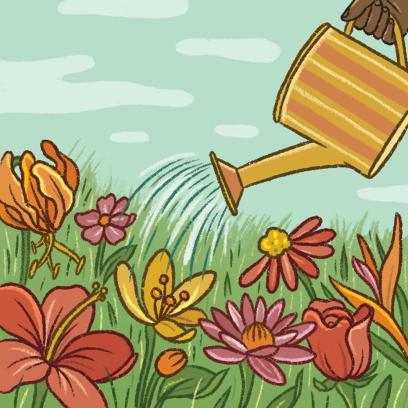In August 2020, I welcomed 400 educators into my Culturally Responsive Education (CRE) by Design Online Professional Learning Community (PLC). This nine-month deep dive into redesigning instruction through a culturally responsive lens went beyond gimmicks and one-off activities. Then, in January 2021, we welcomed another 600 teachers, instructional coaches, and site leaders who wanted to participate. The CRE by Design virtual platform was a few years in the making, long before the pandemic.
I started playing with the idea in 2017, two years after I published Culturally Responsive Teaching and the Brain.1 I wanted to share how the principles of cultural responsiveness, when coupled with the science of learning, can be leveraged for liberatory education—which means positioning students to be the leaders of their own learning by helping them increase their ability to actively improve their cognition.
This is something I learned firsthand when teaching writing to high school students and college freshmen. All of my classroom teaching career was devoted to expository writing. In my credential program, I focused only on writing instruction and reading development. Literacy was (and still is) personal to me. Why? My maternal grandparents who fled the Deep South in 1940 to California were illiterate. Because of Jim Crow segregation, they never got the opportunity to learn to read.
In my early days as an educator, as passionate as I was about helping students become powerful writers, I struggled to help my lowest-performing students of color improve their writing. Many came into my class with skill and knowledge gaps that made critical reading and effective academic writing hard. There was no amount of red ink on their papers that easily changed that reality.
So, I did two things. I stopped using my red pen to correct papers, and I began my own inquiry as teacher-researcher. I leaned into Lisa Delpit’s seminal essay, “The Silenced Dialogue,” which addressed equity and literacy issues for historically marginalized students.2 I wanted to understand how to use the funds of knowledge3 my underprepared students brought with them as an asset to accelerate their growth as writers. I read Linda Christensen, a teacher-scholar with the Oregon Writing Project who went on to author Reading, Writing, and Rising Up, to help me reimagine what a writing class could look like for students of color that centered their language experiences and ways of learning rooted in collectivist cultural principles.4 Over time, with more responsive structures, processes, and routines in place, my writing students slowly became the leaders of their own learning. It was an outcome I went on to replicate over and over again as a writing teacher. When I left the classroom to support equity efforts, I shared this knowledge as a coach and curriculum designer.
Now, this body of knowledge is at the core of the CRE by Design Online PLC. Our primary goal has been to use collaborative inquiry to deepen the effective implementation and impact of culturally responsive practice directly on student learning. We asked the bold question: How do we support historically marginalized students—particularly Black, Latinx, Pacific Islander, and Indigenous students—to be truly independent learners, not just compliant ones? Yet, try as we might, our conversations kept going back to remote learning issues, such as: Should students be able to have cameras off during instruction?
One day during a Zoom Q&A session, a teacher asked the question for the 100th time: “How do I get my students to turn on their cameras?”
“Why is that important to you?” I asked in the spirit of inquiry, trying to get to the real concern behind the question.
“Because it is,” she said adamantly. “I want to make sure they are doing what they are supposed to be doing—otherwise, they will fall behind.”
We then began to talk about how we can spark their intellectual curiosity instead of demanding cameras on. Curiosity, as I shared in Culturally Responsive Teaching and the Brain, stimulates neurotransmitters like dopamine that can entice students and pull them into learning rather than having us cajoling students to engage or making our interactions punitive. Still, there it was: the concern that students were falling behind, especially for students of color and students from under-resourced communities. This concern was coupled with the belief that doubling down on compliance was going to prevent what’s been dubbed “learning loss” during remote learning.
Fast forward to this moment, as we prepare for full-time in-person teaching and learning again. It feels like every day there has been a new national report about the damage done to student achievement as a result of “learning loss” during remote learning.5 Many believe that the academic impact of distance learning will have far-reaching effects that will likely exacerbate long-standing opportunity gaps and resulting inequities in academic achievement. Many school districts are preparing post-COVID-19 plans that are aimed at helping students not lose any more academic ground.
The Racialized Nature of the Learning Loss Conversation
Ironically, early in the pandemic, closing school buildings and sheltering in place (for all but essential workers) laid bare systemic racial inequities in education for children of color across grade levels. As a result of the racial justice reckoning happening alongside the COVID-19 pandemic, more educators were able to see the impact of gross inequities in education. The educational disparities went beyond the digital divide and access to technology: the more insidious gaps were in the ability of students to be independent learners during distance learning.
We had not prepared all students equally to be powerful self-directed learners.6 In some cases, we had relied too heavily on over-scaffolding instruction in the name of equitable access for our neediest students, who are disproportionately children of color growing up in chronically and systemically under-resourced communities.7 For the students most in need of enriching learning experiences, we all too often impose a pedagogy of compliance8 that prizes orderliness and completing work over getting to understanding. This point was highlighted in a recent report, The Opportunity Myth, that summarized a study in which almost 1,000 lessons in five school districts were observed. It found that although 71 percent of students were doing what was asked in their assignments (with more than half receiving As and Bs), they were meeting grade-level standards only 17 percent of the time—mainly because the assignments did not ask for grade-level work.9
It is clear that prior to the pandemic, we failed to help the most marginalized, underperforming students strengthen their cognitive muscles through the process of productive struggle so they could carry more of the cognitive load, which left them unprepared for asynchronous learning situations (and for challenges beyond high school). A majority of these students are children of color* and from low-income families and neighborhoods.10
This reality became painfully obvious during the pandemic, when high numbers of African American, Latinx, Pacific Islander, and Indigenous students learning online from home (or wherever they could find an internet connection) found themselves in their zone of frustration rather than in their ideal zone of proximal development. Many simply disengaged from remote learning by turning their cameras off. Others, especially middle and high schoolers, stopped logging in altogether.
Now, COVID-19 learning loss is being compared with summer learning loss,11 in which some students appear to lose about 25 to 30 percent of their content knowledge and skill between June and September12 (despite some recent analyses questioning the widely accepted concept of summer slide13). My fear is that because of the way we talk about the problem, we will respond as we have in the past (particularly under No Child Left Behind) to disparities in academic achievement: double blocks of literacy and added time for mathematics, while dramatically reducing arts, science, social studies, and, in extreme cases, recess—all in the name of increasing literacy and math scores.14
How do we avoid post-COVID-19 instructional planning becoming a pedagogy of compliance in an effort to get students “caught up”?
Our dominant narratives around learning loss reveal that we are still oriented around a banking model of learning for Black and brown children; we see their minds as empty accounts into which we must deposit knowledge.15 We have framed these students as “behind,” while blaming their teachers and families for not making enough standards-based content deposits. This narrative of learning loss takes a deficit view of home-based and community-based learning. It disregards what students have learned in other contexts and what they have learned in class that does not show up on standardized tests. It disregards their existing funds of knowledge and thus fails to recognize the strong foundations on which we could be building.
We Need a Counter-Narrative to the Idea of Learning Loss
From cognitive science, we know that this banking model is not how learning works.16 Learning is the brain’s prime function—and all of us are wired for high intellectual performance and expansive, self-directed learning, if given the right conditions. Even when we are not aware of it, we are learning all the time—including outside of school. In addition to taking in new information and experiences, we integrate those new bits and pieces of information into our existing background knowledge and mental models (or what cognitive scientists call schema). Realizing that learning happens everywhere, maybe we should be asking different questions: As students devoted less time to traditional classroom-based learning, what did they gain from their home- and community-based learning? What they learned no doubt differs, but have students actually lost anything?
Our counter-narrative to learning loss begins with reframing this period as a time of family- and community-based learning. Children learned something. We need to welcome this new “off topic” knowledge back into the classroom as an asset. If we don’t, we send a dangerous message to students that “real” learning only happens in school. That message robs diverse students of the chance to recognize their own agency as learners. In contrast, our counter-narrative embraces the notion of redesigning teaching and learning for liberatory education.
A Path Forward
What are the implications of liberatory education? How do we reimagine what teaching and learning can be as a result of the new bodies of knowledge students will bring with them? How do we avoid overcompensating with compliance-based practices just because our students’ funds of knowledge do not clearly meet a standards-based learning target? A recent white paper from the Aspen Institute proposes five principles† to guide post-pandemic school planning.17 Here, I elaborate on three that are particularly relevant for us to keep in mind as we create instructional plans to revitalize learning and provide the enrichment all students need to reach their potential:
- View student success over multiple years.
- Use the science of learning to guide us.
- Set an agenda for innovation and continuous improvement.
View Student Success over Multiple Years
Let’s start with viewing student success over multiple years instead of grade by grade. We must prioritize helping students continue to grow as learners before focusing on covering particular grade-level content. Helping diverse students who are historically marginalized become more powerful learners is the endgame of equity. And, that is not going to happen if we are not making room in our curriculum and pacing guides for students to engage in the type of learning behaviors, like productive struggle and academic conversation, that grow the brain’s neural pathways.18 Over time, the brain’s complex network of neural pathways—what we have come to know as “background knowledge”—helps struggling learners do more rigorous and complex work. In short, the more you know, the easier it is to learn.19
Our long view of student success has to be twofold: helping students learn grade-level content while simultaneously coaching them to master essential “learn-how-to-learn” moves that allow them to accelerate their own knowledge and skill mastery over time. We cannot simply give these learn-how-to-learn moves to students. They are cultivated by the students over several years with the coaching support of the teacher and in the context of grasping challenging academic content (i.e., content that is worthy of students’ efforts).
Use the Science of Learning to Guide Us
To succeed in this acceleration, we will have to be guided by the science of learning. Based on my experience, it seems that many elementary school educators are familiar with the science of reading,‡ but fewer have heard about the science of learning and development (though American Educator’s readers have long had the benefit of Daniel T. Willingham’s column,§ “Ask the Cognitive Scientist”). It might seem like the new kid on the block in education circles, but its research foundation stretches back several decades. This body of knowledge we are calling the science of learning is summarized from cross-disciplinary studies highlighting the social and cognitive science behind how young people learn, develop, and grow their brain power to master complex skills.
One particularly compelling synthesis of emerging and established findings is offered by the Science of Learning and Development (SoLD) Alliance.20 This growing partnership of education leaders, researchers, cognitive scientists, and their organizations is united in the belief that these findings present powerful lessons to transform our education systems (and other child-serving systems) to help young people reach their fullest social, emotional, and academic potential. To elevate the essential understandings from this rich body of research, the SoLD Alliance has articulated eight core findings (see the sidebar “Core Findings for Transforming Education” to the right).21 Four of these core findings—malleability, context, meaning-making, and integration—have immediate implications in our post-COVID-19 school design planning, so I draw on them in the discussion that follows, as we build a vision of liberatory education.
Set an Agenda for Innovation and Continuous Improvement
The first of SoLD’s core findings—malleability—is critical for acting on the Aspen Institute’s principle of continuous improvement and innovation as we plan for liberatory education. Malleability reminds us that the brain is highly adaptable and resilient. One’s ability to learn does not stop, and adversity in life is not predictive of one’s cognitive capacity. Our plans for moving past the effects of the pandemic should be inspired and energized by this understanding. While we will need to be sensitive to rebuilding community, repairing relationships with students and families, and helping some families and even whole neighborhoods process the trauma brought on by all the disruption, students are still able to embrace learning when it is purposeful, is joyful, and sparks curiosity.
Liberatory Education = Science of Learning + Culturally Responsive Practice
Although this social-emotional regrounding is essential for healing, it is not sufficient for achieving liberatory education, in which students lead their own learning. We also have to plan for more opportunities for accelerated learning. When I speak of accelerated learning, I am referring to the process of coaching students to expand their ability to process information more effectively and do more complex academic work in order to get more than a year’s academic growth in a year’s time. The ability of a student to learn new content at faster rates with deeper understanding is the hallmark of liberatory education.
It is only through powerful teaching that we can apprentice students to be active agents in their own learning. This process is going to require them to build and braid together multiple neural, relational, and experiential processes to produce their own unique learning acceleration process.22 I like to think of it as “watering up” instructional practices with the science of learning instead of watering them down with the compliance-oriented deficit views.
That is why any effort to accelerate learning to achieve greater equity and help all students reach their potential has to couple the science of learning with culturally responsive practice. These two together create a synergetic effect that promotes more equitable outcomes; their combination helps humanize and empower marginalized learners so that they have the social-emotional capacity to level up their learning. The SoLD Alliance’s core finding of integration reminds us that learning depends on far more than the brain. The brain is nested within the body, and both are nested in a young person’s physical, cultural, cognitive, and emotional environment. Feeling a sense of belonging and intellectual safety free of racial microaggressions is essential.
Connecting Culture and Cognition
Beyond just relationships, we will have to make the culture-cognition connection explicit.23 Too many teachers (as well as professional development providers, professors of education, administrators, etc.) think of culture erroneously in terms of superficial multiculturalism; their intent is well-meaning, but their actions are often limited to promoting racial and social harmony in the classroom by offering a feel-good “It’s a Small World” environment. Others see the limits of multicultural education and focus on social justice education. They add literature or topics to diversify the content in hopes of increasing diverse students’ motivation, engagement, or self-esteem. As summarized in the “Distinctions of Equity” table below, both of these views dramatically underestimate the influence of culture and the instructional changes needed to engage in liberatory education.
In reality, culture—how one makes meaning of the world based on shared beliefs, norms, cosmology, and so forth—is the software to the brain’s hardware. Cultural mental models, understandings, and experiences create cognitive “hooks” or reference points that help to organize our schema into a knowledge network that facilitates our understanding of how things work. Our cultural frames of reference reflect the ways our beliefs, knowledge, and behaviors are patterned on a neurological level.24 The work of being a culturally responsive educator isn’t simply about diverse books or social justice curriculum topics. It’s about gaining insight into your students as learners and being able to craft cognitive hooks between their funds of knowledge and the standards-based content in authentic and meaningful ways that make learning sticky.
Master Moves for Liberatory Instruction
Our ultimate goal is to design learning so students become self-aware and self-directed as learners. Then they can grow their smarts and expand their intellectual capacity. In Culturally Responsive Teaching and the Brain, I offer instructional “master moves” that have a strong connection to the science of learning keys of context and meaning-making as training ground for accelerated learning. Of these master moves, the following three are critical for students to be knowledgeable, not just information filled:
- Expand background knowledge in context.
- Cultivate information processing skills with cognitive “studio” habits.
- Enrich word wealth through contextualized word study.
Expand Background Knowledge in Context
One way that so-called learning loss shows up is in shallow background knowledge. We have to resist thinking that the solution is just about feeding students more random, decontextualized facts and figures. For instruction to be truly liberatory and for learning to be sticky, it has to help students expand what they know, make deep connections across disciplines, and integrate new content into their existing funds of knowledge. This idea of expanding background knowledge is tied to the culturally responsive principle that says: All new information must be coupled with existing funds of knowledge in order to be learned. This is why we have to honor the things students have learned informally during the pandemic. New learning won’t stick if we don’t help students integrate it with their current understandings.
But, helping them make connections isn’t enough. We also need to focus on helping students build and expand their existing background knowledge consistently. Why? The science of learning tells us that background knowledge plays a significant and fundamental role in learning—including in critical thinking and reading comprehension.25 When building a tall skyscraper, the taller the building, the deeper the hole for the foundation must be. The same holds true in education. The more rigorous and complex the learning, the deeper general background knowledge needs to be. Background knowledge is essentially about meaning-making.
The National Research Council’s findings in the seminal report How People Learn26 shows that having background knowledge is not the same as having a collection of disconnected facts. Background knowledge is connected and organized around important concepts (reinforcing this key distinction is why I often use the terms funds of knowledge and schema).
One of the fastest ways to accelerate learning is to authentically build students’ background knowledge.27 Here’s the rub: all new learning must be coupled with and integrated into existing knowledge by the learner, because only the student can build background knowledge.
To cultivate that expansion of background knowledge, teachers can create a variety of opportunities for students to learn new things that might interest them that can be related to the grade-level content they will be covering in future units. And to help broaden students’ interests, teachers can provide space in the curriculum for them to follow their curiosity, with a little scaffolding:
- Create a Netflix-like resource list of developmentally appropriate documentaries, nonfiction books, nature shows, and the like that are linked to the content standards. Ask students to offer titles of movies, graphic novels, and documentaries that they’ve devoured.
- Let students choose content from the resource list once or twice a month.
- Gamify the process to encourage intellectual curiosity that will keep students motivated. For example, use a 30-day challenge format or turn it into a scavenger hunt. Keep it nongraded (learning for the joy of learning).
- Create fun ways for them to process the new information. Ask them to relate it to what they already know using a thinking routine like “I Used to Think, but Now I Think.”
Cultivate Information Processing Skills with Cognitive “Studio” Habits
Although the expansion of background knowledge sounds simple enough, experienced teachers know that this process of integrating new and existing information and understandings is quite challenging. As the thinking routine described above hints at, sometimes prior knowledge is not accurate, which can hinder comprehension and integration of new knowledge. And, even when prior knowledge does not need to be corrected, often new knowledge is only partially understood, which also may hinder assimilation. To help the process of integrating new content with students’ funds of knowledge, teachers need to coach students to develop internal cognitive routines for processing new content that are grounded in the craft and techniques of deep learning.
Building background knowledge and understanding new content requires turning inert facts and figures into usable knowledge. This calls for what I call “cognitive chewing” on the part of the student. In cognitive science, it’s called information processing,28 and it is at the heart of liberatory education. Students need a set of learning-how-to-learn “studio” habits that help them with the business of learning, just like artists develop a set of studio habits to sharpen their craft and technique around their chosen art forms—writing, sculpting, painting, etc.
Too often, when we deem students behind academically, we increase compliance measures and actually decelerate learning. We over-scaffold rather than coach students to engage in productive struggle to process the content. In contrast, liberatory practices grounded in the science of learning focus on building student independence through developing their own repertoire of studio habits.
Note that cognitive studio habits differ from the typical set of disposition-oriented “habits of mind” many teachers are familiar with.29 Those are generalized dispositions toward thinking that are mindfully employed by characteristically intelligent, successful people when they are confronted with challenges during learning.
To help students to cultivate their own studio habits, and thereby improve their information processing skills, teachers can:
- Coach students to be meta-strategic. While the popular notion of metacognition focuses on being an observer of one’s thinking in the moment, being meta-strategic focuses on cognitive planning and task analysis in order to size up the task and select the right cognitive tools and strategies for the job.30
- Provide adequate time for processing. Cognitive scientists have long known that working memory (i.e., the mental space in which information processing happens) is limited—but what does this mean for teaching? Simply put, it means we need to pause active learning to give students time to chew on the new information and make connections with their existing knowledge. Honor this processing time. With our youngest students, it’s helpful to pause and process every few minutes. With adolescents and young adults, pause and process at least every 20 minutes.
- Provide visual processing tools. Effective pausing and processing often requires more active manipulation of the content than we can provide students in a brief turn-and-talk structure. Common processes that add visual supports to ongoing verbal work,** like sketchnoting, thinking maps, or thinking routines (such as “Parts, Purposes, and Complexities”31), can be external tools students add to their internal cognitive toolkit. Over time, these are used less often as external scaffolding tools, and the thinking routine or processing tool becomes a permanent internal cognitive structure in their brain for turning facts and figures from inert information into usable knowledge. The added benefit is that these visual processing tools become part of their lifelong toolkit for thinking through complex problems.
- Offer students the option of choosing from a variety of tools. Everyone doesn’t have to use the same cognitive tool at the same time—though everyone should have the same opportunities to master a variety of tools. For liberatory education, each student is building a customized set of studio habits. When teachers have created time and space for this, it is easier to manage.
Enrich Word Wealth Through Contextualized Word Study
The way the brain organizes and maintains its schema is deeply related to authentic vocabulary development. Think of vocabulary richness as the brain’s Google search engine. Deep background knowledge and word wealth go hand in hand. That is why our third master move is robust, contextualized word study.
When teaching vocabulary development, we have to resist the old school (pun intended) practice of only creating a word wall and not interacting with it or merely front-loading vocabulary without ever talking about those words during a lesson. That’s not how we learn words. We learn them actively in context. Our brain uses the three branches of word study for this process: word play, word consciousness, and word knowledge. This is where the science of learning intersects with the science of reading. When our vocabulary expands, we become better thinkers, stronger readers, and more powerful writers. Why? Because words themselves are a form of background knowledge. When word wealth is developed in context, students are not merely learning vocabulary, they are mastering terms that represent whole bodies of knowledge. These are known as “concept words.” Take the word democracy, for example. A second-grader may learn about democracy with a teacher who engages the children in deciding what their classroom rules will be or by connecting to community norms they are learning at home. An eighth-grader in a US history course may come to understand the complicated aspects of democracy from America’s Jim Crow era through the passage of the Voting Rights Act in 1965. And a 12th-grader in an American civics course may grapple with the strengths and weaknesses of our democracy today in light of globalization.
We have to help students build “word wealth” as part of an ongoing process of building cognitive capacity. The key is making it fun and letting students own the process as their curiosity takes them down different paths based on their own community context. Here are some key tenets of word learning:
- Play with words to stimulate intellectual curiosity about how words work using games like Taboo and providing time for students to explore the words that catch their interest.
- Introduce morphology to students to highlight word knowledge and help them tune into roots, prefixes, and suffixes. Make it a regular practice with each new unit. Begin with word curiosities to spark interest.
- Build word consciousness through the study of word evolution in engaging ways. For example, students can trace the evolution of slang terms across generations and regions through oral interviews (or Zoom chats) with aunts, uncles, and cousins in different age ranges and parts of the country or world.
- Create explicit bridges between vocabulary development and the other master moves described earlier. Coach students to always notice and name similarities and differences in how language is used between their community and school contexts. As students consume the offerings from the Netflix-style resource list for expanding their background knowledge, get them to track new words as well as how familiar words are used in new ways. Teach them to use visual tools specifically for word learning, like a Frayer Model graphic organizer32 or concept mapping, as part of their cognitive studio habits to capture words into their own personal dictionaries. Above all, cultivate a culture of word learning that builds collective word wealth over time.
Conclusion
Many schools will be looking to the science of learning and culturally responsive practice to improve teaching and learning and ameliorate post-COVID-19 learning loss. Yet, so many existing pre-COVID-19 structures, processes, and supposed “best practices” run counter to what we understand about information processing and the eight core findings from the science of learning and development. In addition, there are still myths and misconceptions about culture and the role it plays in learning. We too often reduce culturally responsive teaching to relationships, motivation, or engagement. In reality, it carries the blueprint for liberatory education by helping historically marginalized students who are underperforming to engage in deeper learning by expanding their brain power. We don’t want to miss the moment. Students have been continuously learning during the pandemic at home and in their communities. We have to honor this new knowledge. We have to learn to leverage it wisely.
This simply means that as classroom teachers, instructional coaches, and school site leaders, we will need to be in a continuous process of unlearning, relearning, and reflecting in ways that empower students to be the leaders of their own learning.
Zaretta Hammond, a former writing teacher, has been a national education consultant for more than two decades. She is the author of Culturally Responsive Teaching and the Brain: Promoting Authentic Engagement and Rigor Among Culturally and Linguistically Diverse Students and a member of the Center for the Collaborative Classroom’s Board of Trustees. Previously, she worked with the National Equity Project.
*As explained in “Suppressed History: The Intentional Segregation of America’s Cities” in the Spring 2021 issue of American Educator, Black families were prevented from buying homes and building wealth. (return to article)
†The five principles are "ensure equity and engagement," "take a holistic view to set a coherent strategy," "ground the work int he science of learning," "take a long-term view of student success," and "embed an innovation and learning agenda." The white paper is avilable for free here. (return to article)
‡To ensure your knowledge of the science of reading is up to date, see Teaching Reading Is Rocket Science, 2020 by Louisa C. Moats. (return to article)
§For the latest installment, see here. For the free online archive, see here. (return to article)
** Combining visual and verbal processing, while avoiding the pitfalls of accidentally distracting students, can be tricky. For guidance, see “Sparking Interest, Reducing Learning?” in the Fall 2020 issue of American Educator. (return to article)
Endnotes
1. Z. Hammond, Culturally Response Teaching and the Brain: Promoting Authentic Engagement and Rigor for Diverse Students (Thousand Oaks, CA: Corwin, 2015).
2. L. Delpit, “The Silenced Dialogue: Power and Pedagogy in Educating Other People’s Children,” Harvard Educational Review 58, no. 3 (August 1988): 280–98.
3. L. Moll et al., Funds of Knowledge for Teaching: Using a Qualitative Approach to Connect Homes and Classrooms (Mahwah, NJ: Lawrence Erlbaum Associates, 2005).
4. L. Christensen, Reading, Writing, and Rising Up: Teaching About Social Justice and the Power of the Written Word, 2nd ed. (Milwaukee: Rethinking Schools, 2017).
5. See, for example, M. Kuhfeld and B. Tarasawa, “The COVID-19 Slide: What Summer Learning Loss Can Tell Us About the Potential Impact of School Closures on Student Academic Achievement,” Collaborative for Student Growth brief, NWEA, May 2020; E. Hanushek and L. Woessmann, The Economic Impacts of Learning Losses, Organization for Economic Cooperation and Development, September 2020; E. Dorn et al., “COVID-19 and Learning Loss—Disparities Grow and Students Need Help,” McKinsey, December 8, 2020; and K. Reilly, “The Learning Gap Is Getting Worse as Schools Rely on Remote Classes, Especially for Students of Color,” Time, December 8, 2020.
6. Z. Hammond, “Looking at SoLD Through an Equity Lens: Will the Science of Learning and Development Be Used to Advance Critical Pedagogy or Will It Be Used to Maintain Inequity by Design?,” Applied Developmental Science 24, no. 2 (May 22, 2019): 151–58.
7. G. Ladson-Billings, Dreamkeepers: Successful Teachers of African American Children (San Francisco: Jossey-Bass, 2009).
8. M. Haberman, “The Pedagogy of Poverty Versus Good Teaching,” Phi Delta Kappan 73, no. 4 (December 1991): 290–94.
9. TNTP, The Opportunity Myth: What Students Can Show Us About How School Is Letting Them Down—and How to Fix It, September 25, 2018.
10. B. Love, We Want to Do More Than Survive: Abolitionist Teaching and the Pursuit of Educational Freedom (Boston: Beacon Press, 2020).
11. D. Irving, “The COVID Slide: How to Help Students Recover Learning Losses,” RAND Review, July 9, 2020; and Kuhfeld and Tarasawa, “The COVID-19 Slide.”
12. D. Quinn and M. Polikoff, “Summer Learning Loss: What Is It, and What Can We Do About It?,” Brookings, September 14, 2017.
13. P. von Hippel, “Is Summer Learning Loss Real?: How I Lost Faith in One of Education Research’s Classic Results,” Education Next 19, no. 4 (Fall 2019).
14. Knowledge Matters Campaign, “Restoring Wonder and Excitement to the Classroom,” March 2016, knowledgematterscampaign.org/wp-content/uploads/2016/03/WhyKnowledgeMatters-1.pdf; and Horizon Research, Highlights from the 2018 NSSME+ (Chapel Hill, NC: National Science Foundation, January 2019).
15. Dorn et al., “COVID-19 and Learning Loss”; and Hanushek and Woessmann, The Economic Impacts.
16. Hammond, Culturally Responsive Teaching.
17. Aspen Institute Education and Society Program, “Recovery and Renewal: Principles for Advancing Public Education Post-Crisis,” May 2020.
18. J. Zull, The Art of the Changing Brain: Enriching the Practice of Teaching by Exploring the Biology of Learning (Sterling, VA: Stylus Publishing, 2002).
19. R. E. Nisbett, “Schooling Makes You Smarter: What Teachers Need to Know About IQ,” American Educator 37, no. 1 (Spring 2013): 10–19, 38–39.
20. Science of Learning and Development Alliance, How the Science of Learning and Development Can Transform Education: Initial Findings, May 2020.
21. Science of Learning and Development Alliance, How the Science of Learning.
22. P. Cantor et al., “Malleability, Plasticity, and Individuality: How Children Learn and Develop in Context,” Applied Developmental Science 23, no. 4 (2019): 307–37.
23. National Research Council, How People Learn II: Learners, Contexts, and Cultures (Washington, DC: National Academies, 2018).
24. Y. Jackson, Pedagogy of Confidence: Inspiring High Intellectual Performance in Urban Schools (New York: Teachers College Press, 2011).
25. D. T. Willingham, Why Don’t Students Like School?: A Cognitive Scientist Answers Questions About How the Mind Works and What It Means for the Classroom, 2nd ed. (San Francisco: Jossey-Bass, 2021).
26. National Research Council, How People Learn: Brain, Mind, Experience, and School (Washington, DC: National Academies, 2000).
27. D. Fisher and N. Frey, Background Knowledge: The Missing Piece of the Comprehension Puzzle (New York: Heinemann, 2009).
28. A. W. Boykin and P. Noguera, Creating the Opportunity to Learn: Moving from Research to Practice to Close the Achievement Gap (Alexandria, VA: ASCD, 2011).
29. A. Costa, “Habits of Mind,” Institute for Habits of Mind, habitsofmindinstitute.org/about-us/hear-art.
30. R. Ritchhart, Making Thinking Visible: How to Promote Engagement, Understanding, and Independence for All Learners (San Francisco: Jossey-Bass, 2011).
31. Project Zero, “Parts, Purposes, and Complexities: Looking Closely,” Harvard Graduate School of Education, 2019, pz.harvard.edu/resources/parts-purposes-complexities.
32. IRIS Center, “What Should Content-Area Teachers Know About Vocabulary Instruction: Page 7: Building Vocabulary and Conceptual Knowledge Using the Frayer Model,” Vanderbilt University, 2010, iris.peabody.vanderbilt.edu/module/sec-rdng/cresource/q2/p07.
[illustrations by Gaby D'Alessandro]







